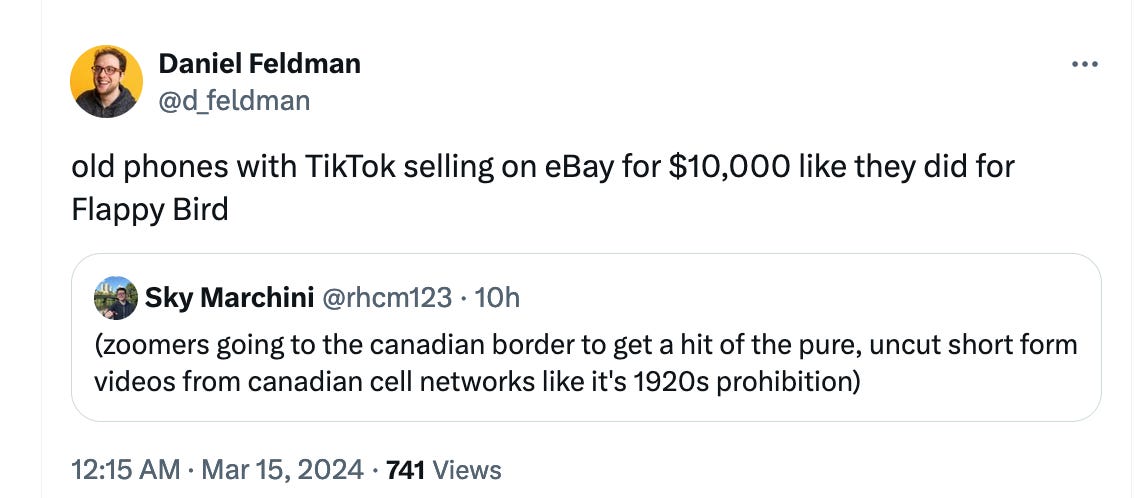I just assumed Republicans and Democrats never agree on anything—until I saw the vote to ban TikTok. It wasn’t even close. The final tally was 352 to 65 in favor of prohibition (or a forced sale of the business to a non-Chinese owner). The bill now goes to the Senate, where results are less certain. This may be the rare instance where legislation gets passed solely because 14-year-olds can’t vote. That’s because TikTok’s most loyal constituency are teens—63% of them are TikTok users. And the Chinese company is enlisting their support in the legal battle. Users is an especially truthful way of describing these youngsters, given the quasi-addictive appeal of this short-video digital platform. The urge to scroll is so extreme that a ban may create a black market for non-US smartphones pre-loaded with the app. Comparisons with the prohibition of alcohol in the 1920s may seem exaggerated, but are they really? TikTok boasts that 170 million people in the US use their app—and many use it constantly. According to one measure, 20% of GenZ users spend five hours or more per day on the app. They don’t go to the mall—TikTok is their mall. They don’t go to the party—TikTok is their party. They don’t go anywhere, or if they do, they keep their eyes glued to the screen. How did we get here? The Honest Broker is a reader-supported guide to music, books, media & culture. Both free and paid subscriptions are available. If you want to support my work, the best way is by taking out a paid subscription.The TikTok timeline started ticking 15 years ago, when a young man named Zhang Yiming quit his job at Microsoft because it was too stifling. That was a wise decision. Zhang’s net worth is now almost $50 billion. His wealth might eventually surpass Microsoft founder Bill Gates’s. But his cultural impact is more hefty than even his bank account. That’s because Zhang is founder of TikTok. His new life as an entrepreneur started with a failure. After leaving Microsoft, the 25-year-old software engineer joined Fanfou, a Twitter-type social media company located in Beijing. But Chinese authorities shut down the website. The US-educated CEO Wang Xing wept at the annual shareholder meeting. But tears failed to soften the hearts of the censors. The company had incited riots, according to party leaders.
When Fanfou finally reopened in 2010, it struggled to regain momentum—but Zhang was already gone. He had learned a lesson, however. In later endeavors, he scrupulously avoided conflicts with powerful people. But making friends in the Chinese government comes at a steep price. The Department of Justice in the US calls Zhang a “mouthpiece” for the Chinese Communist Party. “This is a tool that is ultimately within the control of the Chinese government,” FBI Director Chris Wray recently warned the US Senate Intelligence Committee. You might think that bootlicking of this sort is just how you do business in China. But here’s the interesting twist—TikTok doesn’t exist in China. A similar app, called Douyin, is available in China. TikTok is only for outsiders. And they love it. TikTok has more than 1.5 billion users worldwide. And here’s the secret to his success. Zhang’s key breakthrough came in 2012, when he got excited about the potential for a new kind of social media. Other digital entrepreneurs loved the web, but Zhang loved the algorithm. The mistake previous social media platforms made, he believed, was giving too much control to users. This was messy and led to constant censorship battles. Zhang understood that the real power must reside in the recommendation algorithm—which would put him in control... Keep reading with a 7-day free trialSubscribe to The Honest Broker to keep reading this post and get 7 days of free access to the full post archives. A subscription gets you:
|
Search thousands of free JavaScript snippets that you can quickly copy and paste into your web pages. Get free JavaScript tutorials, references, code, menus, calendars, popup windows, games, and much more.
Where Did TikTok Come From?
Subscribe to:
Post Comments (Atom)
When Bad People Make Good Art
I offer six guidelines on cancel culture ͏ ͏ ͏ ͏ ͏ ͏ ͏ ͏ ͏ ͏ ͏ ͏ ͏ ͏ ͏...
-
code.gs // 1. Enter sheet name where data is to be written below var SHEET_NAME = "Sheet1" ; // 2. Run > setup // // 3....



No comments:
Post a Comment